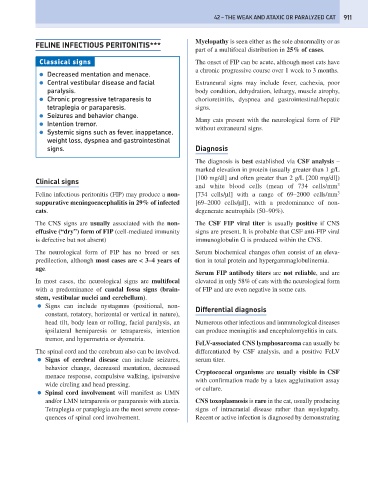Page 919 - Problem-Based Feline Medicine
P. 919
42 – THE WEAK AND ATAXIC OR PARALYZED CAT 911
Myelopathy is seen either as the sole abnormality or as
FELINE INFECTIOUS PERITONITIS***
part of a multifocal distribution in 25% of cases.
Classical signs The onset of FIP can be acute, although most cats have
a chronic progressive course over 1 week to 3 months.
● Decreased mentation and menace.
● Central vestibular disease and facial Extraneural signs may include fever, cachexia, poor
paralysis. body condition, dehydration, lethargy, muscle atrophy,
● Chronic progressive tetraparesis to chorioretinitis, dyspnea and gastrointestinal/hepatic
tetraplegia or paraparesis. signs.
● Seizures and behavior change.
Many cats present with the neurological form of FIP
● Intention tremor.
without extraneural signs.
● Systemic signs such as fever, inappetance,
weight loss, dyspnea and gastrointestinal
signs. Diagnosis
The diagnosis is best established via CSF analysis –
marked elevation in protein (usually greater than 1 g/L
[100 mg/dl] and often greater than 2 g/L [200 mg/dl])
Clinical signs
and white blood cells (mean of 734 cells/mm 3
Feline infectious peritonitis (FIP) may produce a non- [734 cells/μl] with a range of 69–2000 cells/mm 3
suppurative meningoencephalitis in 29% of infected [69–2000 cells/μl]), with a predominance of non-
cats. degenerate neutrophils (50–90%).
The CNS signs are usually associated with the non- The CSF FIP viral titer is usually positive if CNS
effusive (“dry”) form of FIP (cell-mediated immunity signs are present. It is probable that CSF anti-FIP viral
is defective but not absent) immunoglobulin G is produced within the CNS.
The neurological form of FIP has no breed or sex Serum biochemical changes often consist of an eleva-
predilection, although most cases are < 3–4 years of tion in total protein and hypergammaglobulinemia.
age.
Serum FIP antibody titers are not reliable, and are
In most cases, the neurological signs are multifocal elevated in only 58% of cats with the neurological form
with a predominance of caudal fossa signs (brain- of FIP and are even negative in some cats.
stem, vestibular nuclei and cerebellum).
● Signs can include nystagmus (positional, non-
Differential diagnosis
constant, rotatory, horizontal or vertical in nature),
head tilt, body lean or rolling, facial paralysis, an Numerous other infectious and immunological diseases
ipsilateral hemiparesis or tetraparesis, intention can produce meningitis and encephalomyelitis in cats.
tremor, and hypermetria or dysmetria.
FeLV-associated CNS lymphosarcoma can usually be
The spinal cord and the cerebrum also can be involved. differentiated by CSF analysis, and a positive FeLV
● Signs of cerebral disease can include seizures, serum titer.
behavior change, decreased mentation, decreased
Cryptococcal organisms are usually visible in CSF
menace response, compulsive walking, ipsiversive
with confirmation made by a latex agglutination assay
wide circling and head pressing.
or culture.
● Spinal cord involvement will manifest as UMN
and/or LMN tetraparesis or paraparesis with ataxia. CNS toxoplasmosis is rare in the cat, usually producing
Tetraplegia or paraplegia are the most severe conse- signs of intracranial disease rather than myelopathy.
quences of spinal cord involvement. Recent or active infection is diagnosed by demonstrating

